L'Oréal Bundle
How Does L'Oréal Thrive in the Beauty Industry?
L'Oréal, a titan in the beauty sector, consistently captivates with its diverse range of cosmetics, skincare, haircare, and fragrances. Achieving €43.48 billion in sales in 2024, the L'Oréal SWOT Analysis reveals the strategies behind its impressive 5.6% growth, outperforming the global beauty market. This success underscores L'Oréal's influential market position and its ability to adapt to dynamic changes.
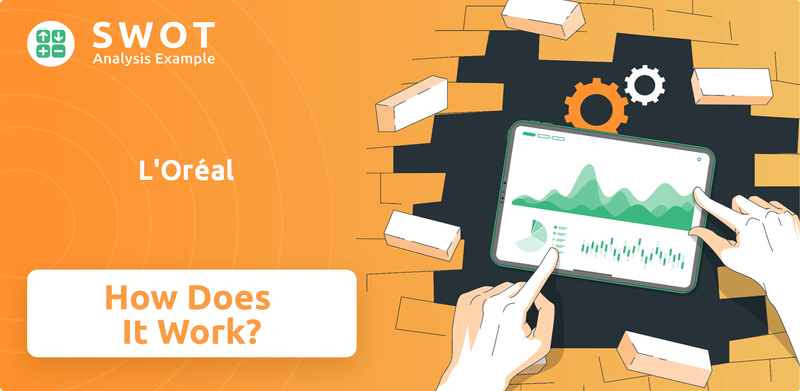
With a presence in over 150 countries and a vast array of L'Oréal Products, understanding How L'Oréal Works is crucial for investors and industry observers. The company's strategic acquisitions, digital transformation, and sustainability initiatives are key drivers of its performance. This exploration will delve into L'Oréal's operational framework, revenue strategies, and its competitive edge in the global market, including how it innovates its products and manages its supply chain process.
What Are the Key Operations Driving L'Oréal’s Success?
The L'Oréal Company operates by developing, manufacturing, and distributing a wide array of beauty products. These products cater to diverse customer segments worldwide. Its core business encompasses four divisions: Professional Products, Consumer Products, L'Oréal Luxe, and Dermatological Beauty, ensuring a broad market reach.
L'Oréal's value proposition lies in its ability to offer products across various price points, from mass-market options to high-end luxury items. This strategy allows the company to capture a significant share of the global beauty market. Innovation and research are central to its operational processes, driving the creation of new and improved products.
The company's commitment to 'Beauty Tech' is a key differentiator, using AI-powered tools for personalized engagement, enhancing customer experiences, and optimizing supply chains. The company's global presence and adaptable distribution model are critical to its success. This approach helps L'Oréal maintain its position as a leader in the beauty industry.
L'Oréal invests over €1 billion annually in Research & Innovation. It employs more than 4,000 researchers across 20 research centers in 11 countries. This extensive R&D network enables the company to develop cutting-edge products, with over 600 new products launched in a recent fiscal year.
L'Oréal operates in over 150 countries, utilizing an omnichannel strategy. This includes e-commerce, mass market, department stores, pharmacies, perfumeries, hair salons, branded stores, and travel retail. This multipolar model allows L'Oréal to adapt to regional nuances and seize growth opportunities across various geographies and price points.
L'Oréal offers a wide range of products under various brands, catering to diverse consumer needs. The portfolio includes makeup, skincare, haircare, and fragrances. This diversified product range supports the company's ability to capture a broad market share and adapt to changing consumer preferences.
L'Oréal leverages advanced data analytics and AI technology to enhance customer experiences. It optimizes supply chains and uses AI-powered tools like virtual try-on apps and skin diagnostics. This focus on 'Beauty Tech' personalizes engagement and provides competitive advantages.
L'Oréal's operational uniqueness combines scientific rigor with a broad brand portfolio and a globally adaptable distribution model. The company's supply chain and distribution networks are extensive, enabling it to reach consumers worldwide. The Professional Products Division has expanded through its omnichannel approach with significant acceleration in e-commerce and selective distribution.
- Extensive Research & Development: Over €1 billion invested annually in R&D.
- Global Market Presence: Operations in over 150 countries.
- Omnichannel Distribution: Utilizing e-commerce, mass market, and specialized retail channels.
- Technological Integration: Employing advanced data analytics and AI for enhanced customer experiences.
L'Oréal SWOT Analysis
- Complete SWOT Breakdown
- Fully Customizable
- Editable in Excel & Word
- Professional Formatting
- Investor-Ready Format
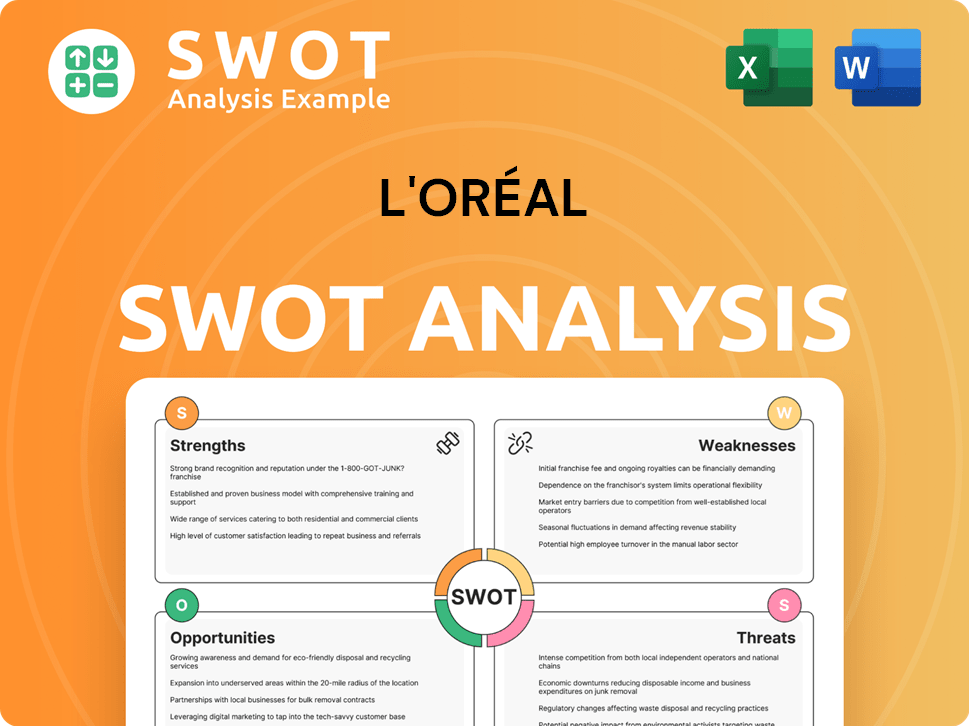
How Does L'Oréal Make Money?
The L'Oréal Company generates revenue through the sale of beauty products across four divisions. These divisions include Professional Products, Consumer Products, L'Oréal Luxe, and Dermatological Beauty. Understanding the revenue streams and monetization strategies of L'Oréal is essential for anyone interested in the L'Oréal Business Model.
In 2024, L'Oréal reported consolidated sales of €43.48 billion, demonstrating its strong market position. Its diverse portfolio and strategic approach to sales and marketing contribute significantly to its financial success. For additional information about the company's ownership, you can read more about the Owners & Shareholders of L'Oréal.
The company employs various monetization strategies, including digital transformation and tiered pricing. These strategies, along with strategic partnerships and acquisitions, allow L'Oréal to maintain its competitive edge in the beauty industry.
The Dermatological Beauty Division saw remarkable growth in 2024. Sales increased by 9.8% like-for-like, surpassing the €7 billion mark.
The Consumer Products Division, which includes well-known L'Oréal Products brands, experienced a 5.3% rise in sales in 2024. This division focuses on both mass-market and premium beauty products.
L'Oréal Luxe posted a 4.5% growth in 2024, driven by strong fragrance sales. Fragrances from couture brands played a significant role in this growth.
The Professional Products Division saw a 5% increase in sales in 2024. Premium haircare and an omnichannel strategy supported this growth.
Online sales contributed 30% of total revenue in 2023. This highlights the importance of L'Oréal's digital marketing strategies.
The long-term beauty partnership with Jacquemus in 2025 and minority stakes in Galderma and Amouage expand the portfolio. This shows how L'Oréal acquires other brands.
Key strategies include digital transformation, tiered pricing, and strategic partnerships. These contribute to L'Oréal's success in the beauty market.
- Digital Transformation: Online sales are a significant revenue driver.
- Tiered Pricing: Catering to various consumer budgets.
- Strategic Partnerships: Expanding market reach and portfolio.
- Diverse Brand Portfolio: Covering mass-market to luxury segments.
L'Oréal PESTLE Analysis
- Covers All 6 PESTLE Categories
- No Research Needed – Save Hours of Work
- Built by Experts, Trusted by Consultants
- Instant Download, Ready to Use
- 100% Editable, Fully Customizable
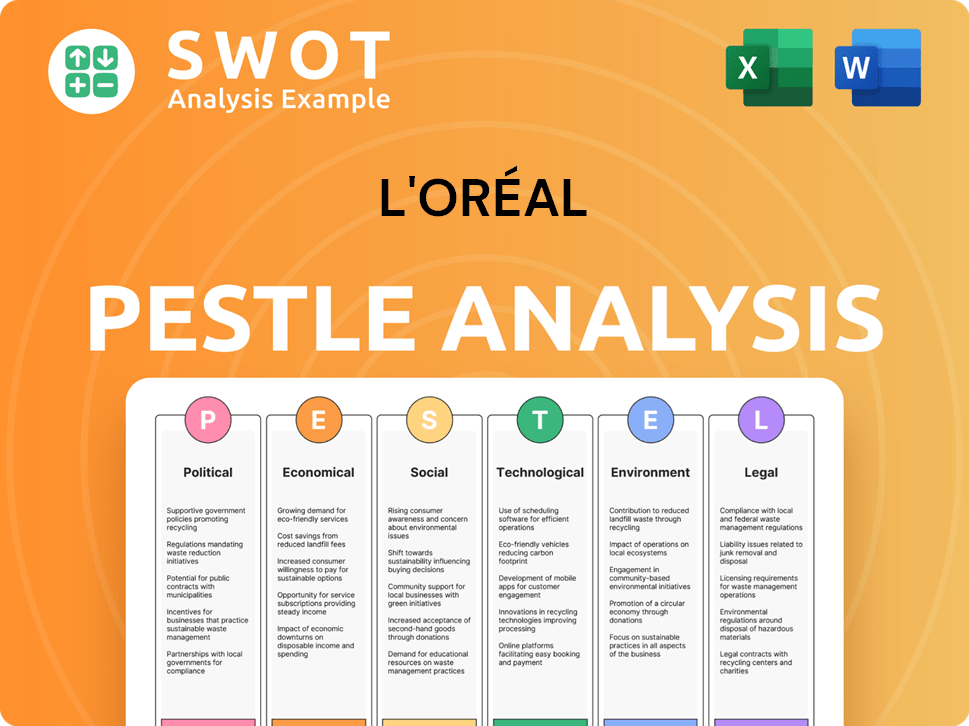
Which Strategic Decisions Have Shaped L'Oréal’s Business Model?
The journey of the L'Oréal Company has been marked by significant milestones and strategic decisions that have solidified its position as a leader in the beauty industry. One of the most important strategic moves in recent years has been the increasing emphasis on 'Beauty Tech,' which involves integrating artificial intelligence and technology into both product development and consumer engagement. This is shown by the opening of its new US Research & Innovation Centre in February 2025, the largest R&I hub outside of France.
L'Oréal has also made strategic investments, such as acquiring the Miu Miu license and the Korean brand Dr. G, and taking minority stakes in Galderma and Amouage. These moves have helped the company refine its portfolio and expand into new areas of the beauty market. Despite facing market challenges, including geopolitical tensions and inflationary pressures, L'Oréal has shown resilience and the ability to outperform the global beauty market.
In 2024, L'Oréal achieved a 5.1% like-for-like sales growth, demonstrating its ability to navigate difficult market conditions. The company's multipolar model, which uses complementary growth drivers across regions, categories, and divisions, has been key in offsetting temporary softness in certain areas. Its focus on innovation, global presence, and brand strength continues to drive its success.
The opening of the new US Research & Innovation Centre in February 2025, the largest R&I hub outside France, highlights L'Oréal's commitment to innovation. Strategic acquisitions and investments, such as the Miu Miu license and the Korean brand Dr. G, have expanded its portfolio. These moves showcase L'Oréal's proactive approach to growth and market adaptation.
The integration of 'Beauty Tech,' using AI and technology, is a key strategic focus for product development and consumer engagement. The company's multipolar model, which uses complementary growth drivers across different regions, categories, and divisions, has been crucial for offsetting market challenges. These moves reflect L'Oréal's adaptability and forward-thinking approach.
A strong brand portfolio, including L'Oréal Paris, Maybelline, Lancôme, and Kiehl's, allows the company to cater to a wide range of consumer preferences. Sustained investment in innovation and research, with over €1 billion invested annually, keeps the company ahead of trends. A global presence in over 150 countries provides extensive market access. Effective marketing strategies, including celebrity endorsements, contribute to strong brand awareness and sales.
L'Oréal delivered a 5.1% like-for-like sales growth in 2024, demonstrating its resilience and ability to outperform the global beauty market. The company's strategic investments and focus on innovation have supported its financial performance. These figures show the company's ability to navigate market challenges and maintain growth.
L'Oréal's competitive advantages include a strong brand portfolio, continuous investment in innovation, and a global presence. Effective marketing and advertising strategies, often involving celebrity endorsements, boost brand awareness. The company's commitment to sustainability, as outlined in its 'L'Oréal for the Future' program, enhances its brand reputation.
- A diverse brand portfolio, including L'Oréal Products, caters to various consumer preferences.
- Sustained investment in research and development, with over €1 billion annually, drives innovation.
- Global presence in over 150 countries provides extensive market access, and helps in L'Oréal's Business Model.
- Effective marketing and advertising strategies, often involving celebrity endorsements, contribute to strong brand awareness.
- Commitment to sustainability enhances brand reputation and appeals to environmentally conscious consumers.
L'Oréal Business Model Canvas
- Complete 9-Block Business Model Canvas
- Effortlessly Communicate Your Business Strategy
- Investor-Ready BMC Format
- 100% Editable and Customizable
- Clear and Structured Layout
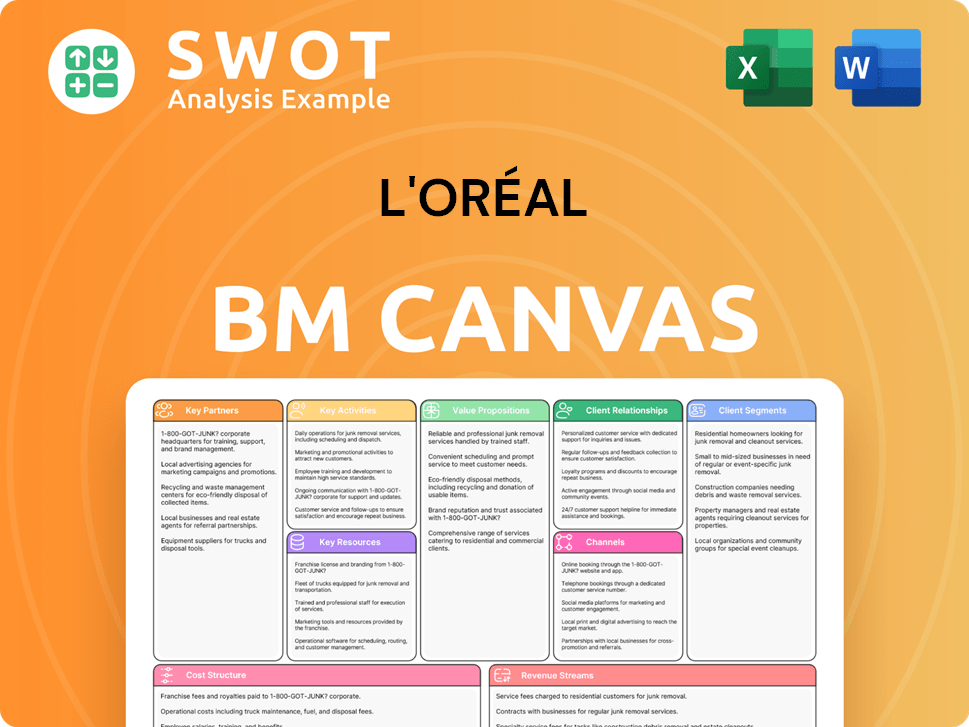
How Is L'Oréal Positioning Itself for Continued Success?
As a global leader, the L'Oréal Company maintains a strong foothold in the beauty industry. In 2024, L'Oréal demonstrated its market dominance by outperforming the global beauty market, achieving a like-for-like sales growth of 5.1%. This success is backed by a diverse brand portfolio and a balanced geographical presence, with growth in Europe and emerging markets compensating for challenges in North Asia.
However, L'Oréal faces several key risks. Geopolitical tensions and inflationary pressures are ongoing concerns. The beauty market in China has experienced softness, impacting sales, and regulatory changes pose challenges. The beauty industry is also susceptible to changing consumer preferences, such as the growing demand for clean beauty and sustainable products. Currency fluctuations due to its international presence also present a financial risk. For more insights, read about the Target Market of L'Oréal.
L'Oréal is the leading beauty company globally, recognized for its extensive brand portfolio and balanced geographical presence. The company's diverse offerings, ranging from luxury to mass-market products, drive customer loyalty. Continuous innovation, especially in dermatological beauty, strengthens its market position.
Key risks include geopolitical tensions, inflationary pressures, and market softness in China. Regulatory changes and currency fluctuations also pose challenges. The beauty industry's susceptibility to changing consumer preferences, such as demand for clean beauty and sustainable products, requires continuous adaptation.
L'Oréal anticipates accelerated growth in the global beauty market for 2025, driven by new launches and brand support. The company aims for a revenue target of €40 billion by 2025. Strategic initiatives include expanding into emerging markets and enhancing digital capabilities.
Key strategies include expanding into emerging markets, which accounted for 30% of total sales in 2022. L'Oréal is focused on enhancing its digital capabilities, investing in research and innovation in areas like 'Green Sciences' and 'Beauty Tech'. The 'L'Oréal for the Future' program outlines sustainability targets.
L'Oréal is committed to achieving carbon neutrality in global manufacturing sites by 2025 and reducing scope 1 and 2 CO2 emissions by 50% by 2030. The company's investments in 'Green Sciences' and 'Beauty Tech' aim to shape the future of beauty with personalized, inclusive, and sustainable solutions.
- Focus on sustainable product development.
- Investment in 'Green Sciences' and 'Beauty Tech'.
- Expansion into emerging markets.
- Enhancement of digital capabilities.
L'Oréal Porter's Five Forces Analysis
- Covers All 5 Competitive Forces in Detail
- Structured for Consultants, Students, and Founders
- 100% Editable in Microsoft Word & Excel
- Instant Digital Download – Use Immediately
- Compatible with Mac & PC – Fully Unlocked
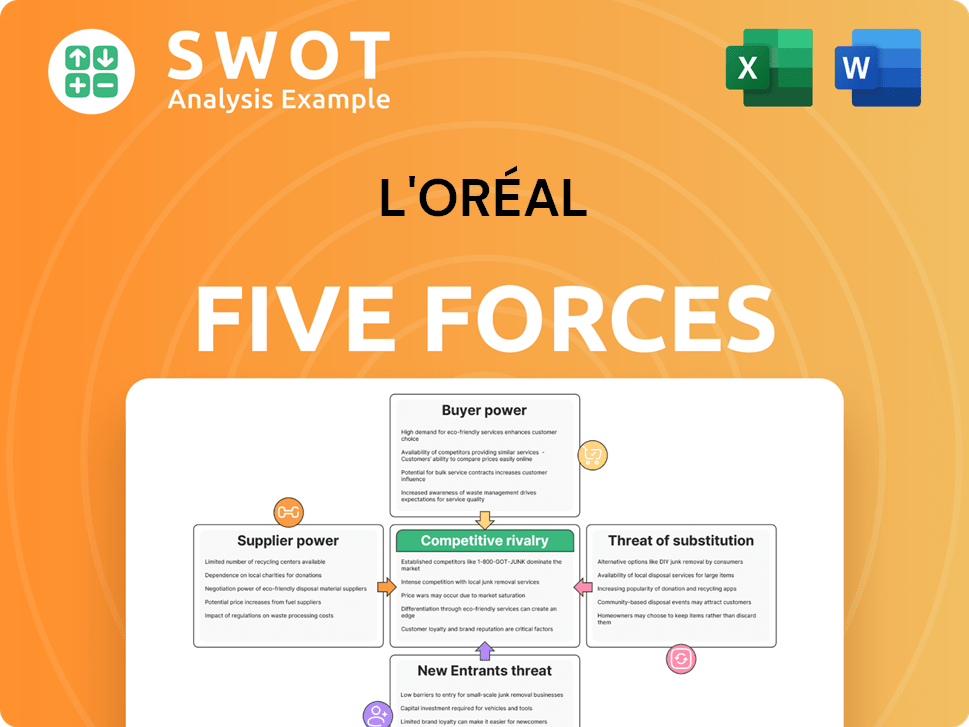
Related Blogs
- What are Mission Vision & Core Values of L'Oréal Company?
- What is Competitive Landscape of L'Oréal Company?
- What is Growth Strategy and Future Prospects of L'Oréal Company?
- What is Sales and Marketing Strategy of L'Oréal Company?
- What is Brief History of L'Oréal Company?
- Who Owns L'Oréal Company?
- What is Customer Demographics and Target Market of L'Oréal Company?
Disclaimer
All information, articles, and product details provided on this website are for general informational and educational purposes only. We do not claim any ownership over, nor do we intend to infringe upon, any trademarks, copyrights, logos, brand names, or other intellectual property mentioned or depicted on this site. Such intellectual property remains the property of its respective owners, and any references here are made solely for identification or informational purposes, without implying any affiliation, endorsement, or partnership.
We make no representations or warranties, express or implied, regarding the accuracy, completeness, or suitability of any content or products presented. Nothing on this website should be construed as legal, tax, investment, financial, medical, or other professional advice. In addition, no part of this site—including articles or product references—constitutes a solicitation, recommendation, endorsement, advertisement, or offer to buy or sell any securities, franchises, or other financial instruments, particularly in jurisdictions where such activity would be unlawful.
All content is of a general nature and may not address the specific circumstances of any individual or entity. It is not a substitute for professional advice or services. Any actions you take based on the information provided here are strictly at your own risk. You accept full responsibility for any decisions or outcomes arising from your use of this website and agree to release us from any liability in connection with your use of, or reliance upon, the content or products found herein.